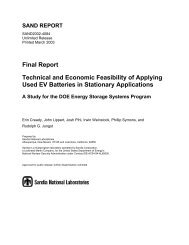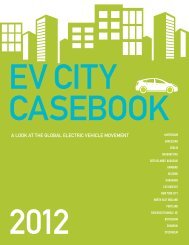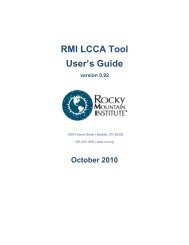Fleet Electrification Roadmap
Fleet Electrification Roadmap
Fleet Electrification Roadmap
- No tags were found...
Create successful ePaper yourself
Turn your PDF publications into a flip-book with our unique Google optimized e-Paper software.
138 part four: policy recommendations other policiesfleet electrification roadmap 139to an accelerated pace of technological advancement inbattery production, driving down costs. Large fleet purchaseswill also give automotive and battery OEMs thelong-term stability needed to justify significant investmentsin labor and equipment.Despite the existence of executive orders that directagencies to purchase efficient and advanced vehicles,agencies often choose to meet the requirements in theleast expensive manner. Rather than forcing agenciesto pay the incremental costs of GEVs out of their ownbudgets, Congress should establish a program at theGeneral Services Administration that will pay the incrementalcosts of GEVs purchased or leased by federalagencies. Directly appropriating funds for that purposewould allow agencies to operate GEVs without takingscarce funds away from their core missions. Moreover,introducing this program and transparency to the adoptionof GEVs by federal agencies will allow Congress andthe public to better calibrate the rate at which GEVs areincorporated into the federal fleet.Post OfficeAs of 2009, the United States Postal Service (USPS) hadnearly 220,000 vehicles in operation. The vast majorityof the vehicles—nearly 195,000—were light trucks.According to a 2009 report by the USPS Office of theInspector General, the average daily mail-delivery drivingdistance is 18 miles, making many of these vehicleswell-suited for right-sized EV batteries or smaller PHEVbatteries. Moreover, the average age and usage patternsof vehicles currently in the postal fleet lead to extremelyhigh maintenance costs. Substituting EVs and PHEVswould result in sharply lower fuel costs in addition tooffsetting high maintenance costs.The key issue for the USPS has been funding theupfront investment needed to acquire EVs and PHEVs.As a semi-private institution, the post-office has limitedaccess to capital and may actually face additional, uniquefunding challenges. In 2009, the USPS faced a $7 billionfunding shortfall. Of course, reducing fuel and maintenancecosts could contribute to a stronger position overtime, but access to capital today is still a key issue.From an economic standpoint, the IG report foundthat value was achievable in the right circumstances.Specifically, the report found that if “the upfront capitalcost is overcome by participation in DOE-fundeddemonstration programs and V2G revenue is captured,the agency [breaks] even within the first 2 years thatEVs are in operation.” The report goes on to state that“Funding specifically targeting Postal Service maildelivery vehicles would likely be necessary to create aneconomic environment that provides incentives for thePostal Service to move into a leadership position with EVtechnology.”Given the size and purchasing power of the USPS,the federal government should offset the incrementalupfront cost of EV and PHEV purchases by the PostOffice for the period 2011-2014 through direct appropriationsto the USPS. At the end of this four-year period,the Inspector General should be required to produce ananalysis of the program and make recommendations onthe need for a possible second phase.Policy RecommendationClarify the tax code to ensure that Section30D GEV tax credits are available toconsumers who purchase a GEV (withouta battery) and lease the battery from thedealer or a third party at the time thevehicle is purchased.Section 30D of the U.S. tax code allow purchasers toreceive a tax credit of between $2,500 and $7,500 for aplug-in vehicle with a battery whose capacity exceeds 4kWh. The size of the tax credit is dependent on the size ofthe battery. As currently written, it appears that a vehiclemay not qualify for the credit if the battery is not purchasedwith the vehicle and the owner of the vehicle doesnot own the battery. Because consumers who lease a batterywill effectively pay for it even if they do not own it,Congress should clarify the tax code so that purchasersof GEVs who lease a battery (or the right to use a batteryowned by the lessor) at the time of purchase are eligiblefor the tax credit, so long as the battery is physicallyinstalled in the vehicle at the time of original purchase.
















